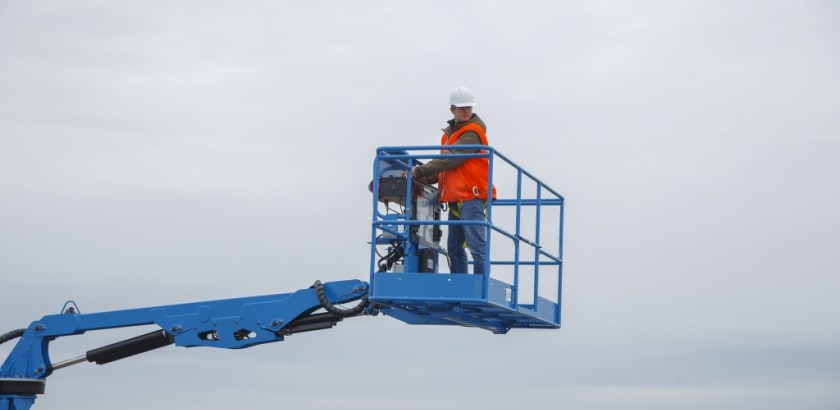Clearing Up the Confusion: Fall Protection Requirements on Group B MEWPs

When it comes to using fall protection equipment for on mobile elevating work platforms (MEWPs), many still do not fully understand, or comprehend, the requirements in the ANSI A92 and CSA B354 standards, as well as the OSHA and OHS requirements, for fall protection on MEWPs in the United States and Canada.
It is not that the industry is completely unaware; in fact, the majority of MEWP operators are aware that PFPE (personal fall protection equipment) is required when operating either self-propelled or trailer-mounted booms. After that point, it becomes a hodgepodge of misinformation, causing a lot of confusion in the industry.
To help clear up the confusion, there are two key things everyone needs to know: First, the primary means of fall protection on all MEWPs is provided by the guardrail system. And second, there are some instances when a second level of fall protection is required by the standards for MEWPs in North America.
Following outlines those specific instances and provides details MEWP operators need to know:
Fall Protection Requirements on Manually-Propelled and Scissor Lift Products
Standards for Type 1, Group A (1A) manually-propelled elevating work platforms and Type 3, Group A (3A) self-propelled elevating work platforms, such as scissor lifts and single personnel lifts, do not require the use of personal fall protective equipment (PFPE) in addition to guardrails.1
However, if a user, employer or local government regulations requires an operator to use PFPE in addition to guardrails on these MEWPs, lanyard attachment points are provided for this purpose by Genie. For example, some provinces in Canada, such as Saskatchewan, Ontario and Nova Scotia have regulations that do require all occupants in a scissor lift to wear PFPE.
Fall Protection Requirements on Booms
The use of approved PFPE in addition to a guardrail for operator fall protection is required in the United States and Canada for Type 1, Group B (1B) and Type 3, Group B (3B) boom-supported MEWPs. This requirement is mandated by the standards for Mobile Elevating Work Platforms1 and Vehicle-Mounted Elevating and Rotating Aerial Devices2 and is enforced by OSHA in the United States and OHS and provincial authorities in Canada.
There are two types of secondary fall protection for MEWPs: Fall Restraint and Fall Arrest.
Fall Restraint
Fall restraint systems prevent a MEWP occupant from being exposed to any fall. If the person is protected by a restraint system, either a body belt or a full body harness may be used. When a restraint system is used for fall protection in a Group B MEWP, the employer/user/operator must ensure that the lanyard and anchor are arranged so that the operator is not exposed to falling any distance outside the platform.
Fall Arrest
A system that permits an arrested fall is considered a fall arrest system. A body belt is prohibited in a fall arrest system; instead, a full body harness and lanyard that limits the fall distance and arresting force on the person is required. Fall arresting lanyards typically have a shock absorbing section or are a self-retracting lifeline/lanyard.
The following is a general summary of fall protection requirements as discussed above for Group B MEWPs:
- The user is responsible for providing approved fall protection for employees3.
- A personal fall arrest system used on a boom type MEWP cannot allow the operator to fall more than 6 ft4.
- A personal fall arrest system used on a boom type MEWP cannot allow the operator to come into contact with any lower surface4.
Now let’s take a look at what secondary fall protection options are for Group B MEWPs.
During travel in the stowed position and whenever the platform height is below the calculated total fall distance (or whenever they are above the calculated total fall distance) for every operator and occupant:
- The operator and all occupants must wear a full body harness with either a fall restraint system or 6-ft maximum length self-retracting lifeline (which has been approved for use on a MEWP by the manufacturer);
-or
- A full body harness with a double lanyard system (fall arrest and fall restraint);
- The fall restraint lanyard must be used during travel in the stowed position and when the platform height is below the calculated total fall distance.
- The fall arrest lanyard can be used when the platform height is above the calculated total fall distance and when all other factors have been taken into consideration.
- It is no longer acceptable to place two double-locking snap hooks to a single D-ring. When using a double lanyard system, such as the one mentioned here, MEWP occupants must use a D-ring extension to separate the two devices. Never use a side d-ring for fall arrest;
So, what is the final takeaway here? It is never acceptable to use a 6-ft shock-absorbing lanyard by itself when operating a Group B MEWP.
Even if MEWP operators are loading or unloading a truck, moving the machine in the yard or other tasks, it is critical that each person is protected against harm. It is important that each MEWP occupant is equipped with the proper fall protection equipment as outlined in this article.
1ANSI A92.22-2018 and CSA B354.7:17
2ANSI A92.2-2015 and CSA C225
3OSHA Title 29 CFR 1926.501(a)(1)
4OSHA Title 29 CFR 1926.502(d)(16)(iii)
